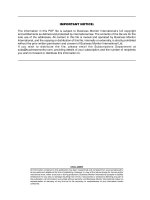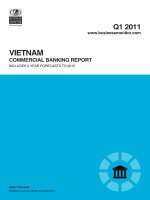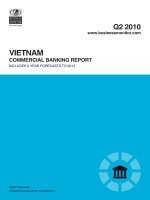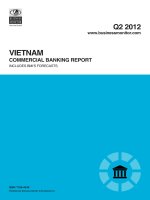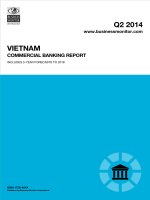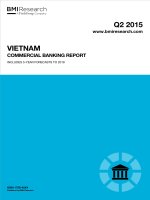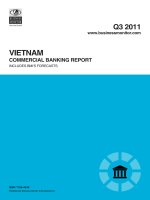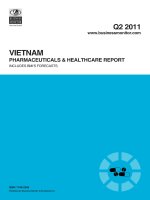Vietnam freight transport report q2 2011
Bạn đang xem bản rút gọn của tài liệu. Xem và tải ngay bản đầy đủ của tài liệu tại đây (398.52 KB, 37 trang )
Q2 2011
www.businessmonitor.com
VietnaM
freight transport Report
INCLUDES BMI'S FORECASTS
ISSN 1750-5364
Published by Business Monitor International Ltd.
VIETNAM
FREIGHT TRANSPORT
REPORT Q2 2011
INCLUDES 5-YEAR FORECASTS TO 2015
Part of BMI’s Industry Survey & Forecasts Series
Published by: Business Monitor International
Copy deadline: January 2011
Business Monitor International
Mermaid House,
2 Puddle Dock,
London, EC4V 3DS,
UK
Tel: +44 (0) 20 7248 0468
Fax: +44 (0) 20 7248 0467
email:
web:
© 2011 Business Monitor International.
All rights reserved.
All information contained in this publication is
copyrighted in the name of Business Monitor
International, and as such no part of this publication
may be reproduced, repackaged, redistributed, resold in
whole or in any part, or used in any form or by any
means graphic, electronic or mechanical, including
photocopying, recording, taping, or by information
storage or retrieval, or by any other means, without the
express written consent of the publisher.
DISCLAIMER
All information contained in this publication has been researched and compiled from sources believed to be accurate and reliable at the time of
publishing. However, in view of the natural scope for human and/or mechanical error, either at source or during production, Business Monitor
International accepts no liability whatsoever for any loss or damage resulting from errors, inaccuracies or omissions affecting any part of the
publication. All information is provided without warranty, and Business Monitor International makes no representation of warranty of any kind
as to the accuracy or completeness of any information hereto contained.
Vietnam Freight Transport Report Q2 2011
© Business Monitor International Ltd
Page 2
Vietnam Freight Transport Report Q2 2011
CONTENTS
Executive Summary ......................................................................................................................................... 5
SWOT Analysis ................................................................................................................................................. 7
Vietnam Freight Transport SWOT ......................................................................................................................................................................... 7
Vietnam Political SWOT ........................................................................................................................................................................................ 7
Vietnam Economic SWOT ...................................................................................................................................................................................... 8
Vietnam Business Environment SWOT................................................................................................................................................................... 8
Market Overview ............................................................................................................................................. 10
Industry Trends And Developments ............................................................................................................ 12
Multimodal And Logistics .................................................................................................................................................................................... 12
Rail ...................................................................................................................................................................................................................... 12
Road .................................................................................................................................................................................................................... 13
Maritime .............................................................................................................................................................................................................. 13
Global Oil Products Price Outlook ............................................................................................................... 16
Table: Oil Product Price Assumptions, Q410-Q411 (US$/bbl)............................................................................................................................ 16
Table: Oil Product Price Data And Forecasts, 2008-2015 (US$/bbl) ................................................................................................................. 19
Industry Forecast ........................................................................................................................................... 21
Macroeconomic Outlook...................................................................................................................................................................................... 21
Road Freight ........................................................................................................................................................................................................ 21
Table: Road Freight , 2008-2015......................................................................................................................................................................... 21
Rail Freight ......................................................................................................................................................................................................... 21
Table: Rail Freight , 2008-2015 .......................................................................................................................................................................... 22
Air Freight ........................................................................................................................................................................................................... 22
Table: Air Freight , 2008-2015 ............................................................................................................................................................................ 22
Maritime Freight ................................................................................................................................................................................................. 22
Table: Maritime Freight – Throughput, 2008-2015 (‘000 tonnes) ....................................................................................................................... 23
Table: Inland Waterway Freight , 2008-2015 ...................................................................................................................................................... 23
Trade ................................................................................................................................................................................................................... 23
Table: Trade Overview , 2008-2015 .................................................................................................................................................................... 24
Table: Vietnam’s Main Import Partners, 2002-2008 (US$mn) ............................................................................................................................ 24
Table: Vietnam’s Main Export Partners, 2002-2008 (US$mn) ............................................................................................................................ 24
Table: Key Trade Indicators , 2008-2015 ............................................................................................................................................................ 25
Company Profiles ........................................................................................................................................... 26
Doan Xa Port ....................................................................................................................................................................................................... 26
Vietnam Airlines .................................................................................................................................................................................................. 28
Vietnam Petroleum Transport Jsc (VIPCO)......................................................................................................................................................... 30
Country Snapshot: Vietnam Demographic Data ......................................................................................... 31
Section 1: Population........................................................................................................................................................................................... 31
Table: Demographic Indicators, 2005-2030 ........................................................................................................................................................ 31
Table: Rural/Urban Breakdown, 2005-2030 ....................................................................................................................................................... 32
Section 2: Education And Healthcare .................................................................................................................................................................. 32
Table: Education, 2002-2005 .............................................................................................................................................................................. 32
Table: Vital Statistics, 2005-2030 ........................................................................................................................................................................ 32
Section 3: Labour Market And Spending Power .................................................................................................................................................. 33
Table: Employment Indicators, 1999-2004 .......................................................................................................................................................... 33
Table: Consumer Expenditure, 2000-2012 (US$) ................................................................................................................................................ 33
© Business Monitor International Ltd
Page 3
Vietnam Freight Transport Report Q2 2011
BMI Methodology ........................................................................................................................................... 34
How We Generate Our Industry Forecasts .......................................................................................................................................................... 34
Transport Industry ............................................................................................................................................................................................... 34
Sources ..................................................................................................................................................................................................................... 35
© Business Monitor International Ltd
Page 4
Vietnam Freight Transport Report Q2 2011
Executive Summary
Foreign interest in Vietnam's transport infrastructure is growing; international investors realise the growth
potential in a market where trade volumes are expanding beyond the capabilities of a logistics sector
stunted by years of underinvestment. There are plans to open four new container terminals in the Ho Chi
Minh port area alone between 2011 and 2013. Growing international interest in Vietnam is reflected in
our macroeconomic forecasts; Vietnam's real GDP growth came in at a better-than-expected 7.4% yearon-year (y-o-y) in Q310, supported by robust growth in the construction and manufacturing sectors. The
latest figures remain in line with our view that private consumption and infrastructure investments would
continue to drive economic growth. Our real GDP forecast for 2011 remains at 5.6% in anticipation of a
slowdown in external demand.
Headline Industry Data
Air freight tonnes + 5.25% to 147.91 from 140.54 in 2010
Air freight tonnes/ km + 4.88% to 327.73 from 312.48 in 2010
Port of Ho Chi Minh tonnage + 7.45% to 21,843.71 from 20,329.57 in 2010
Port of Da Nang tonnage +2.76% to 3,292.86% from 3,204.35 in 2010
Road freight tonnes/km + 6.88% to 30,186.26 from 28,242.09 in 2010
Inland waterway freight/km +4.53% to 27,365.02 from 26,179.87 in 2010.
Key Industry Trends
Multimodal/ Logistics
China's SITC To Build Logistics Park In Vietnam, Reflecting Growing International Interest
BMI believes that SITC International Holdings Company (SITC)'s plans to build and operate a
logistics park in Haiphong's Dihn Vu Port is a further indication of growing international interest in
Vietnam, as it becomes a significant export nation. The agreement announced in November will see SITC
International, through its wholly owned subsidiary SITC Shipping Asia PTE, establish a joint venture
(JV) named SITC-Dinh Logistics Co with Dinh Vu Port Development and Investment Joint Stock
Company in Haiphong. The JV company will carry out logistics between Vietnam and neighbouring
Asian countries.
Rail
Vietnam Looks to China to Improve Intra-Asia Rail Links
BMI expects Asian rail freight infrastructure to come under the spotlight in the coming years as intraAsia trade grows. We have previously reported on the explosion of international interest in intra-Asia
© Business Monitor International Ltd
Page 5
Vietnam Freight Transport Report Q2 2011
shipping routes. We are now noting a trend of growing Chinese investment in rail links in the region as it
seeks to improve trade links with the ASEAN countries. Vietnam's Minister of Transport Ho Nghia Dung
has confirmed plans to create a partnership with the Chinese government to upgrade the existing main
lines between Hanoi, Hai Phong and the Chinese border crossings at Lao Cai and Dong Dang by 2020.
Road
New Trucking Service To Capitalise On Intra-Asia Trade
APL Logistics has launched a new containerised cross-border trucking service, which will cater for
customers between Phnom Penh in Cambodia and Cai Mep Port in Vietnam. The new service provides
shippers with a later cut-off time at a container freight station in Phnom Penh. The service is designed to
cater for shippers when production runs unexpectedly late. This will also reduce transit time between the
two destinations. The company introduced the service as Cai Mep emerges as a significant gateway for
growing trade through Vietnam.
Maritime
International Lines Increase Calls as Vietnam Becomes Export Centre
BMI continues to single out Vietnam as an outperformer in the sector as its role grows in the global box
shipping sector. The country is set to benefit from direct links with the US and Europe, and in BMI's
opinion will become a focal point for many lines' expansion into intra-Asia trade routes.
In November 2010 CMA CGM became the latest global shipping line to add Vietnam as a direct port of
call to its Asia-Europe services. The French carrier added the Vietnamese port of Cai Mep to its FrenchAsia Line 3 (FAL3).
Risks To Outlook
The main risk to our outlook is on the downside. Further investment is needed to ensure that Vietnamese
ports can handle an expected increase in traffic. If that is not forthcoming, Vietnamese ports will become
congested and will lose business to better prepared neighbours due to lack of capacity. As Vietnam's role
in the box shipping sector increases, more pressure will be placed on the country's port infrastructure.
Vietnam is attracting investment into its port sector with four new container terminals planned to be
launched between 2011 and 2013 in the Ho Chi Minh port area alone. However, BMI fears that this will
not be enough, and that although port-side investment is flooding in, money is also needed further up the
logistics supply chain for the country's road and rail sectors.
Further downside risk comes from the possibility of a slowdown in China. As mentioned, China is
funding much of the infrastructure development in Vietnam. Any decline here will directly impact
Vietnam's freight transport sector. A slowdown in external demand for Vietnamese exports presents a
similar downside risk.
© Business Monitor International Ltd
Page 6
Vietnam Freight Transport Report Q2 2011
SWOT Analysis
Vietnam Freight Transport SWOT
Strengths
Weaknesses
Opportunities
Threats
Vietnam's strong domestic growth rate coupled with its geography: a long country
stretching for thousands of kilometres on a north-south axis creates a need for longdistance freight haulage.
Recovery of the nation's ports in 2010 is expected to continue over the mid-term.
Vietnam's location on the South China Sea gives the country access to the main interAsian shipping routes, as well as access to the developing land transport links with
ASEAN countries, allowing the country scope to develop its trade logistics.
The generally poor state of the road network. Despite new highway construction, only
13.5% of the road network is considered to be in good condition, only 26% has two or
more lanes and only 29% is tarred.
Traditionally low investment in rail; although attempts are being made to rectify this,
the potential of rail for cost-effective bulk freight is being under-utilised.
Decades of under-investment have left the country with a port infrastructure system
that is poor by international standards.
The beginnings of local commercial vehicle production, which will help improve the
stock of lorries used by road haulage companies.
Chinese investment could bring about much needed improvements in the rail sector.
Growing international interest in Vietnam as a growth market within the box shipping
sector.
Vietnam risks losing out to neighbouring countries if it can't develop its infrastructure
to keep up with the pace of demand.
Vietnam is vulnerable to any slowdown in Chinese investment.
A drop in international demand for exports would negatively effect Vietnam's freight
transport sector.
Vietnam Political SWOT
Strengths
Weaknesses
Opportunities
The Communist Party government appears committed to market-oriented reforms,
although specific economic policies will undoubtedly be discussed at the 2011
National Congress. The one-party system is generally conducive to short-term political
stability.
Relations with the US are generally improving, and Washington sees Hanoi as a
potential geopolitical ally in South East Asia.
Corruption among government officials poses a major threat to the legitimacy of the
ruling Communist Party.
There is increasing (albeit still limited) public dissatisfaction with the leadership's tight
control over political dissent.
The government recognises the threat that corruption poses to its legitimacy, and has
acted to clamp down on graft among party officials.
Vietnam has allowed legislators to become more vocal in criticising government
policies. This is opening up opportunities for more checks and balances within the
one-party system.
© Business Monitor International Ltd
Page 7
Vietnam Freight Transport Report Q2 2011
Threats
The slowdown in growth in 2009 and 2010 is likely to weigh on public acceptance of
the one-party system, and street demonstrations to protest economic conditions could
develop into a full-on challenge of undemocractic rule.
Although strong domestic control will ensure little change to Vietnam's political scene
in the next few years, over the longer term, the one-party-state will probably be
unsustainable.
Relations with China have deteriorated over the past year due to Beijing's more
assertive stance over disputed islands in the South China Sea and domestic criticism
of a large Chinese investment into a bauxite mining project in the central highlands,
which could potentially cause widescale environmental damage.
Vietnam Economic SWOT
Strengths
Weaknesses
Opportunities
Threats
Vietnam has been one of the fastest-growing economies in Asia in recent years, with
GDP growth averaging 7.6% annually between 2000 and 2009.
The economic boom has lifted many Vietnamese out of poverty, with the official
poverty rate in the country falling from 58% in 1993 to 20% in 2004.
Vietnam still suffers from substantial trade, current account and fiscal deficits, leaving
the economy vulnerable as the global economy continues to suffer in 2010. The fiscal
picture is clouded by considerable 'off-the-books' spending.
The heavily-managed and weak dong reduces incentives to improve quality of
exports, and keeps import costs high, thus contributing to inflationary pressures.
WTO membership has given Vietnam access to both foreign markets and capital,
while making Vietnamese enterprises stronger through increased competition.
The government will in spite of the current macroeconomic woes, continue to move
forward with market reforms, including privatisation of state-owned enterprises, and
liberalising the banking sector.
Urbanisation will continue to be a long-term growth driver. The UN forecasts the urban
population to rise from 29% of the population to more than 50% by the early 2040s.
Inflation and deficit concerns have caused some investors to re-assess their hitherto
upbeat view of Vietnam. If the government focuses too much on stimulating growth
and fails to root out inflationary pressure, it risks prolonging macroeconomic instability,
which could lead to a potential crisis.
Prolonged macroeconomic instability could prompt the authorities to put reforms on
hold, as they struggle to stabilise the economy.
Vietnam Business Environment SWOT
Strengths
Weaknesses
Vietnam has a large, skilled and low-cost workforce, that has made the country
attractive to foreign investors.
Vietnam's location - its proximity to China and South East Asia, and its good sea links
- makes it a good base for foreign companies to export to the rest of Asia, and
beyond.
Vietnam's infrastructure is still weak. Roads, railways and ports are inadequate to
cope with the country's economic growth and links with the outside world.
Vietnam remains one of the world's most corrupt countries. Its score in Transparency
International's 2009 Corruption Perceptions Index was 2.7, placing it in 22nd place in
the Asia-Pacific region.
© Business Monitor International Ltd
Page 8
Vietnam Freight Transport Report Q2 2011
Opportunities
Threats
Vietnam is increasingly attracting investment from key Asian economies, such as
Japan, South Korea and Taiwan. This offers the possibility of the transfer of high-tech
skills and knowhow.
Vietnam is pressing ahead with the privatisation of state-owned enterprises and the
liberalisation of the banking sector. This should offer foreign investors new entry
points.
Ongoing trade disputes with the US, and the general threat of American protectionism,
which will remain a concern.
Labour unrest remains a lingering threat. A failure by the authorities to boost skills
levels could leave Vietnam a second-rate economy for an indefinite period.
© Business Monitor International Ltd
Page 9
Vietnam Freight Transport Report Q2 2011
Market Overview
In January 2007 Vietnam officially joined the WTO, an event seen as an important milestone in the
country's closer integration into the global economy. WTO membership has helped boost Vietnam's
international trade and develop its freight transport capabilities.
Road transport is the most advanced in terms of freight sector privatisation and is the dominant mode for
freight, with a market share of around 60% of domestic cargo. There are over 1,050 enterprises registered
in the road transport business, which include 16 state-owned enterprises (SOEs), 233 limited liability
companies, 350 private companies and 450 joint stock companies. Very few foreign-invested companies
are present.
Most road transport companies are of small or medium size, and each company, on average, owns about
50 vehicles. In addition, tens of thousands of individual household businesses exist that operate
informally in the road freight sector, and are thus difficult to account for and monitor.
Vietnam has a national road network of 222,179km. Of this, only 42,167km, or 19%, is paved. In
addition, recent surveys indicate that approximately 40% of the network is in poor to very poor condition
and will require substantial investment even to reach a maintainable condition. The quality of Vietnam's
road infrastructure was judged by the World Economic Forum (WEF) to be poor and was ranked 102 out
133 nations surveyed in the WEF 2010 Global Competitiveness Report.
Vietnam's railway transport sector has only one operator, the Vietnam Railway Corporation (VRC),
established in April 2003 as a state corporation operating railway transport and related services. The
government has announced plans to separate the management of rail infrastructure from passenger and
cargo services. Vietnam's rail network totals 2,600km (excluding sidings). The network is mixed-gauge,
comprising 2,169km of 1.000m gauge and 178km of 1.435m gauge. The network has 1,790 bridges
totalling 45km and 11.5km of tunnels. The principal axis is Hanoi-Ho Chi Minh City (1,726km). Other
lines emanating from Hanoi are to Hai Phong (102km), Lao Cai (296km) and Dong Dang (162km).
Railway infrastructure in Vietnam was ranked 58 out of 114 by the WEF.
There are two principal airlines operating in Vietnam: Vietnam Airlines and Pacific Airlines. Both are
majority state owned, although Australia's Qantas is now a minority shareholder in Pacific Airlines. The
government has announced plans to build the country's largest airport at Long Thanh in the southern
province of Dong Nai, at an estimated cost of US$8bn. The authorities also plan to expand Noi Bai
International airport in Hanoi. The three major airports handling freight are located at Ho Chi Minh City,
Hanoi and Da Nang, each of which have international connecting flights. Minor airports such as Cat Bi at
Haiphong are generally used for domestic flights to the three larger hubs. In 2010, Vietnam's air transport
infrastructure was ranked 84/ 133 nations by the WEF.
© Business Monitor International Ltd
Page 10
Vietnam Freight Transport Report Q2 2011
Vietnam's dense river and canal network provides the country with a highly developed inland waterway
system. This is the second-largest sub-sector involved in domestic cargo transport, accounting for 25-30%
of total transport volumes. The inland waterway transport sub-sector is managed by two state corporations
affiliated to the Ministry of Transport, one SOE affiliated to the Vietnam Inland Waterway Authority, and
some enterprises managed by other ministries, operating in support of the power generation, cement and
paper industries. In addition, there are about 230 co-operatives and hundreds of inland waterway transport
enterprises in the country.
Vietnam's seaport network comprises of many small- and medium-sized entities, with inefficient
distribution. Most big ports are located far inside rivers, like Hai Phong and Ho Chi Minh City, with
limited depth at the entrance. Some ports are located in big cities, thus making it difficult to connect with
other modes of transport for cargo transfer to and from ports, due to traffic congestion. Except for several
new or upgraded ports, most have been operating for many years and lack investment and are seriously
degraded.
The loading and unloading equipment in some ports is obsolete, leading to low productivity. The average
productivity of a Vietnamese port is only 2,500 tonnes/m per wharf, or 40-50% of productivity of other
ports in the region.
Vietnam's port infrastructure is poor by international standards. The World Economic Forum's 2010
Global Competitiveness Report gives it a score of 3.56, putting it just ahead of the regional
underperformer, the Philippines, which scores 2.92, and well behind regional leaders Singapore and Hong
Kong. Increasing international interest in Vietnam's port sector on the back of growing intra-Asia trade
should help to close the gaps in infrastructure investment.
© Business Monitor International Ltd
Page 11
Vietnam Freight Transport Report Q2 2011
Industry Trends And Developments
Multimodal And Logistics
China's SITC To Build Logistics Park In Vietnam, Reflecting Growing International Interest
BMI believes that plans by SITC International Holdings Company (SITC) to build and operate a
logistics park in Haiphong's Dihn Vu Port is a further indication of growing international interest in
Vietnam, as it becomes a significant export nation.
The agreement announced in November will see SITC International, through its wholly owned subsidiary
SITC Shipping Asia PTE, establish a joint venture (JV), named SITC-Dinh Logistics Co, with Dinh
Vu Port Development and Investment Joint Stock Company in Haiphong. The joint venture company
will carry out logistics between Vietnam and neighbouring Asian countries, covering door-to-door
services that include shipping agency, multimodal transport, trucking, container freight stationing,
warehousing, forwarding, container repair and customer declaration services.
The JV will lease a 30,000 square metre (sq m) container yard in Dinh Vu Port on which it will build and
operate logistics park facilities for a total investment of US$2mn. SITC International will contribute 49%
and Dinh Vu Port 51% to the JV company. SITC International plans to replicate its existing Qingdao
Logistics Park at Dihn Vu, creating a 'customer-oriented integrated logistics park' near port, highway and
rail facilities as well as enhancing sea, land and airfreight services and distribution and delivery.
BMI notes that the plan forms part of a wider move by SITC to expand its operations in Association of
Southeast Asian Nations (ASEAN) countries. SITC International chairman and executive director, Yang
Shaopeng, said: 'We are positive about the trade among ASEAN countries and will expand our container
shipping network to cover more ports in ASEAN countries including Vietnam, Thailand and Indonesia.
Establishing ancillary land-based logistics services nearby these ports comes as part of our strategy.'
Rail
Vietnam Looks to China to Improve Intra-Asia Rail Links
BMI expects Asian rail freight infrastructure to come under the spotlight in the coming years as intraAsia trade grows. We have previously reported on the explosion of international interest in intra-Asia
shipping routes. We are now noting a trend of growing Chinese investment in rail links in the region as it
seeks to improve trade links with the ASEAN countries. Vietnam's Minister of Transport Ho Nghia Dung
has confirmed plans to create a partnership with the Chinese government to upgrade the existing main
lines between Hanoi, Hai Phong and the Chinese border crossings at Lao Cai and Dong Dang by 2020.
Speaking at a conference hosted by state railway company DSVN, the minister said the routes were
important freight corridors but the poor quality of track and signalling is limiting capacity. The
Vietnamese and Chinese governments have created a partnership to plan electrification and double-
© Business Monitor International Ltd
Page 12
Vietnam Freight Transport Report Q2 2011
tracking to provide an operational 1,435 mm-gauge route from the Chinese border points to Hanoi.
Currently the Dong Dang line is mixed gauge, while the Lao Cai line is one metre gauge.
This is the latest in a series of Chinese initiatives to improve rail links with other Asia countries. China
has already announced plans to construct rail links between Kunming, the regional capital of Yunnan
province, and Laos and Myanmar. Chinese contractors have completed an update of a 2005 feasibility
study for a 257km line between Phnom Penh in Cambodia and Loc Ninh in Vietnam. China has
reportedly offered US$600mn to fund its construction by 2015.
BMI believes the push to increase intra-Asia transport links over the past 12 months has a lot to do with
the projected increase in trade in the region on the back of a free-trade agreement (FTA) signed between
China and the founding ASEAN nations in January 2010. The FTA has eliminated tariffs on 90% of
goods traded between the countries and China. A reduction in import tariffs between China and the
ASEAN boosted trade between the two by 47% to US$185bn within the first eight months of 2010.
China's commitment to improving rail links with Vietnam is good news for the country's underfunded
freight transport sector. We have previously highlighted the considerable gaps in funding in Vietnam's
infrastructure. The country's rapid economic growth has far outpaced its infrastructure, creating major
bottlenecks in ports and a constraint on export led-growth and investment.
Road
New Trucking Service To Capitalise On Intra-Asia Trade
APL Logistics has launched a new containerised cross-border trucking service, which will cater for
customers between Phnom Penh in Cambodia and Cai Mep Port in Vietnam. The new service provides
shippers with a later cut-off time at a container freight station in Phnom Penh. The service is designed to
cater for shippers when production runs unexpectedly late. This will also reduce transit time between the
two destinations. The company introduced the service as Cai Mep is emerging as a significant gateway
for growing trade through Vietnam.
Maritime
International Lines Increase Calls as Vietnam Becomes Export Centre
BMI continues to single out Vietnam as an outperformer in the sector as its role grows in the global box
shipping sector. The country is set to benefit from direct links with the US and Europe, and in BMI's
opinion will become a focal point for many lines' expansion into intra-Asia trade routes.
In November 2010 CMA CGM became the latest global shipping line to add Vietnam as a direct port of
call to its Asia-Europe services. The French carrier added the Vietnamese port of Cai Mep to its FrenchAsia Line 3 (FAL3). The 70-day service offers calls at the Asian ports of Qingdao, Ningbo, Chiwan,
Nansha, Yantian and Kelang, and will link Vietnam with the major European ports of Malta, Le Havre,
Dunkirk, Zeebrugge, Hamburg, Rotterdam and Southampton.
© Business Monitor International Ltd
Page 13
Vietnam Freight Transport Report Q2 2011
CMA CGM's FAL3 service will become the carrier's only service offering a direct link between Vietnam
and European ports. Although it might be the company's only service to offer this, CMA CGM is
displaying its confidence in Europe's demand for Vietnamese goods by operating 10 8,500-9,500 20-foot
equivalent unit (TEU) vessels on this service, the largest vessels to have pulled into the new deepwater
port of Cai Mep.
Japan's Nippon Yusen Kaisha (NYK Line) is also cementing its role in Vietnam's maritime sector with a
new route linking the country with ports in Thailand and Singapore. NYK Line has joined forces with
Vietnam's box carrier Vinalines Container Shipping Company (VCSC) and was due to launch a
Thailand-Vietnam-Singapore (TVS) service on December 21 2010.
BMI notes that this is not the first time NYK and Vinalines have paired up on a Vietnam project. The two
carriers, along with Mitsui OSK Line (MOL) and the Itochu Corporation, got the go-ahead in
September 2010 to develop two wharves at the Vietnamese port of Haiphong. NYK is also developing a
new container terminal at Cai Mep in conjunction with Hanjin Shipping and Wan Hai, reflecting Japan's
increasing interest in Vietnam.
In November 2010 United Arab Shipping Company (UASC) and the container arm of the China
Ocean Shipping Company (COSCON) became the latest box lines to begin calling at DP World's
Vietnamese operation, the Saigon Premier Container Terminal (SCPT). The terminal has been attracting
many of the major container lines leading BMI to increase its forecast for total throughput at the port. The
terminal only opened in October 2009, but since then has attracted a number of customers, with UASC
and COSCON joining France's CMA CGM, Malaysia's MISC Berhad and Japan's NYK Line in making
calls at the facility.
Although UASC and COSCON's calls at SCPT are not part of the current big-money services, they show
the further development of the intra-Asia trade route. UASC's SEA3 service is a weekly shuttle between
the facility and the Malaysian port of Port Klang. SCPT has been added to one of COSCON's intra-Asia
services, SCS, which also calls at the Chinese ports of Nansha and Shekou, the ports of Hong Kong and
Singapore, and the Indonesian ports of Surabaya and Jakarta.
Terminal Operators Race To Cash In On Vietnam
BMI has noted a trend of international companies developing facilities at Vietnamese ports, indicating
growing international interest in Vietnam, as it becomes a significant export nation. Plans by SITC
International Holdings Company (SITC) to build and operate a logistics park in Haiphong's Dihn Vu Port
are a further reflection of this view.
Further international interest in Vietnam came from Seattle-based Carrix, the world's largest privately
held rail and marine terminal operator, which plans to build a new container terminal in Quang Ninh
province. The move reflects BMI's belief that US trade with Vietnam will continue to grow as the country
develops into a major export nation.
© Business Monitor International Ltd
Page 14
Vietnam Freight Transport Report Q2 2011
Cai Lan International Container Terminal, (CICT) a joint venture between Carrix and the Vietnamese
company Cai Lan Port Investment Joint Stock Company, has secured a US$100mn loan agreement
with a consortium of lenders to build a deepwater container terminal in Northern Vietnam. CICT will
have a draft of 10m and 598m of berth, enabling it to receive ships of up to 4,000 TEU. Phase One
capacity will be 510,000 TEU a year, and when completed the terminal will be able to handle 1.2mn TEU
a year. Construction will be completed next year.
Infrastructure Failings Jeopardise Vietnam Ports Boom
Despite these positive developments, BMI cautions that further investment is needed to ensure that
Vietnamese ports can handle an expected increase in traffic. As Vietnam's role in the box shipping sector
increases, more pressure will be placed on the country's port infrastructure. Vietnam is attracting
investment in its port sector with four new container terminals planned to be launched between 2011 and
2013 in the Ho Chi Minh port area alone. However, BMI fears that this will not be enough, and that
although port-side investment is flooding in, money is also needed further up the logistics supply chain
for the country's road and rail sectors.
© Business Monitor International Ltd
Page 15
Vietnam Freight Transport Report Q2 2011
Global Oil Products Price Outlook
Blood On The Forecourts
Once again, severe winter weather conditions have been a mixed blessing for the oil markets. Sentiment
benefited, as did the price of heating oil, as businesses and consumers struggled to ensure supply. On the
flip side, however, there were major disruptions to fuel movements and demand. Overall oil consumption
during the winter months is unlikely to have benefited significantly from the unusually low temperatures
and the positive pricing effect will prove temporary. However, the strength of underlying crude prices
means that all refined products are priced at uncomfortable levels, which poses a threat to consumption.
Table: Oil Product Price Assumptions, Q410-Q411 (US$/bbl)
Gasoline
Q410
Q111e
Q211f
Q311f
Q411f
Rotterdam Premium Unleaded
94.61
97.89
89.69
86.06
94.14
NY Harbour Unleaded
94.65
96.79
87.63
84.47
94.18
95
98.75
87.95
84.25
94.53
94.75
97.81
88.42
84.93
94.28
Rotterdam
99.72
97.68
91.35
90.2
99.23
NY Harbour
99.97
99.16
90.89
90.38
99.47
Singapore
98.57
96.46
90.35
88.61
98.08
Global average
99.42
97.76
90.87
89.73
98.93
Rotterdam
97.45
95.04
89.56
88.45
96.97
Mediterranean
97.46
95.19
89.77
88.42
96.98
Singapore
97.33
96.27
89.94
88.13
96.85
Global average
97.41
95.5
89.76
88.33
96.93
87.6
87.86
76.86
74.07
87.16
Mediterranean
87.71
87.38
76.7
73.68
87.27
Singapore
88.02
88.42
78.08
73.67
87.58
Global average
87.78
87.89
77.21
73.8
87.34
Singapore Premium Unleaded
Global average
Jet/kerosene
Gasoil
Naphtha
Rotterdam
e/f = estimate/forecast. Source: BMI
© Business Monitor International Ltd
Page 16
Vietnam Freight Transport Report Q2 2011
In December 2010 International Energy Agency (IEA) region end‐user prices rose by 3.6% in US dollar
terms (excluding tax), with gasoline up 3.5% and diesel prices 2.9% higher. Heating oil and low‐sulphur
fuel oil increased by 4.6% and 3.5%, respectively. Compared with December 2009 average price levels in
surveyed IEA‐member countries saw a 15.9% year‐on‐year (y-o-y) increase. The big price gains were
automotive diesel (20.3%) and heating oil (19.5%). Canada saw gasoline prices rise by a steep 25.8%
y‐o‐y, while the British heating oil price increased by 33.9%.
It is becoming evident that consumers are reducing fuel purchases as a reaction to record pump prices.
The return of cold weather will no doubt maintain support for heating oil, but automotive diesel and
gasoline sales will continue to struggle. As in the summer of 2008, prices have reached a level where socalled 'demand destruction' becomes a major factor. It can be seen that the US and European markets
were changed permanently by the last period of record pump prices. Should we have a prolonged period
of pump price strength, there will be blood on the forecourts as consumers reduce journey times and the
move towards more efficient vehicles accelerates.
Uncomfortable Levels
Oil Product Price Data And Forecasts, 2008-2014 (US$/bbl)
e/f = estimate/forecast. Source: International Energy Agency, BMI forecasts
In Britain and indeed in Europe motor vehicle fuel economy is improving by 3-4% a year, with an
obvious knock-on effect in terms of gasoline and diesel use. With the US planning higher standards for
car fuel efficiency, gasoline producers in developed markets will continue to have a hard time, with most
new growth in fuels demand coming from the non-OECD world. Even here, however, reductions in fuel
subsidies and price liberalisation could mean that higher pump prices have a negative impact on demand
trends at a critical time for the oil market.
© Business Monitor International Ltd
Page 17
Vietnam Freight Transport Report Q2 2011
US gasoline consumption in 2010 was a disappointment, and there is no reason to expect anything better
in 2011. Even the Energy Information Administration (EIA) sees a likely increase in US fuels
consumption of no more than 160,000b/d (0.8%), followed by 170,000b/d growth in 2012. Consumption
continues to be dominated by gasoline, where price sensitivity is at its greatest. In 2008 US gasoline
demand fell 2.6% y-o-y thanks to the higher cost of the fuel during the summer months. It will take very
little to trigger a similar outcome in 2011. Given that throughout the OECD it was much the same story in
2008, demand projections for 2011 look particularly vulnerable in a high-price environment.
At present the EIA forecasts an increase in regular‐grade gasoline retail prices from US$2.78 per gallon in
2010 to US$3.17 in 2011 (+14%). On‐highway diesel fuel retail prices, which averaged US$2.99/gallon
in 2010, are predicted to be US$3.40 in 2011. Not only is the crude price effect reflected in these price
projections, but the US body expects wider gasoline and distillate refining margins to contribute to higher
retail prices. The EIA warns that there is an 8-10% risk of summer 2011 gasoline pump prices exceeding
US$4.00/gallon.
Revised Forecasts
In Q410 BMI estimates that the global wholesale price for premium unleaded gasoline was
US$94.75/bbl. This compares with US$83.16 in Q310. Gasoline prices in Q410 were up 16.4% from
US$81.41 in Q409. For the whole of 2010 the BMI calculation for gasoline is an average US$88.36/bbl.
The overall y-o-y rise in 2010 gasoline prices is put at 25.9%.
For Q111 we assume a global unleaded price of US$97.81/bbl, up 3.2% from Q410 and a y-o-y rise of
11.6%. The full year 2011 wholesale gasoline price forecast is US$91.36/bbl, up 3.4% y-o-y.
In Q410 gasoil averaged US$97.41/bbl, based on a BMI-calculated composite global price. This was a yo-y rise of 19.8%. For 2010 as a whole BMI calculations suggest an average price of US$89.32/bbl,
peaking in December 2010 at more than US$101/bbl. The full-year outturn is a 29.5% y-o-y increase. It
can be seen that gasoil outperformed gasoline in price terms, as economic recovery stimulated demand.
For Q111 we assume a global gasoil price of US$95.50/bbl, representing a downturn from the Q410 level
as weather factors subside, but a y-o-y rise of 13.5%. The full year 2011 wholesale gasoil price forecast is
US$92.63/bbl, up 3.7% y-o-y.
Jet prices averaged an estimated US$99.42/bbl in Q410, using the composite for New York, Singapore
and Rotterdam. The y-o-y increase was just over 19%, with jet almost matching the gain in gasoil prices.
Quarter-on-quarter (q-o-q) the increase was 13.2%. For 2010 as a whole the level is believed to have been
US$91.00/bbl. This compares with US$70.66/bbl in 2009 (+28.8%).
For Q111 we assume a global wholesale jet price of US$97.76/bbl, again representing a slight downturn
from the Q4 level, but a y-o-y rise of 13.2%. The full year 2011 wholesale jet price forecast is
US$94.32/bbl, or a y-o-y increase of 3.6%.
© Business Monitor International Ltd
Page 18
Vietnam Freight Transport Report Q2 2011
Table: Oil Product Price Data And Forecasts, 2008-2015 (US$/bbl)
Gasoline
2008
2009
2010e
2011f
2012f
2013f
2014f
2015f
Rotterdam Premium Unleaded
100.12
70.6
88.96
91.94
97.69
103.44
103.44
103.44
NY Harbour Unleaded
102.54
69.7
87.77
90.77
96.44
102.11
102.11
102.11
Singapore Premium Unleaded
102.64
70.21
88.36
91.37
97.08
102.79
102.79
102.79
Global average
101.77
70.17
88.36
91.36
97.07
102.78
102.78
102.78
Rotterdam
126.61
70.81
91.22
94.61
100.53
106.44
106.44
106.44
NY Harbour
127.13
71.18
91.69
94.98
100.91
106.85
106.85
106.85
Singapore
121.11
69.99
90.1
93.37
99.21
105.05
105.05
105.05
Global average
124.95
70.66
91
94.32
100.22
106.11
106.11
106.11
Rotterdam
122.62
68.74
89.23
92.5
98.29
104.07
104.07
104.07
Mediterranean
121.75
69.13
89.28
92.59
98.38
104.17
104.17
104.17
Singapore
119.53
69.01
89.46
92.8
98.6
104.4
104.4
104.4
121.3
68.96
89.32
92.63
98.42
104.21
104.21
104.21
87.31
58.76
78.71
81.49
86.58
91.67
91.67
91.67
Mediterranean
86.2
58.38
78.43
81.26
86.34
91.42
91.42
91.42
Singapore
88.7
60.75
79.23
81.94
87.06
92.18
92.18
92.18
Global average
87.4
59.3
78.79
81.56
86.66
91.76
91.76
91.76
Jet/kerosene
Gasoil
Global average
Naphtha
Rotterdam
e/f = estimate/forecast. Source: 2000-2006 data: Energy Information Administration; 2007-2010 data: International
Energy Agency; forecasts: BMI
In Q410 naphtha averaged US$87.78/bbl on an estimated global basis, compared with US$72.27/bbl in
Q310 and US$73.44 in Q409. We put the 2010 average naphtha price at US$78.79/bbl, up almost 33% yo-y. Thanks to the growth of petrochemicals demand in Asia, naphtha was once again the star performer
in 2010, having also beaten the other key products in 2009.
For Q111 we assume a global wholesale naphtha price of US$87.89/bbl, virtually unchanged from Q410,
but a y-o-y rise of 12.2%. The full year 2011 wholesale naphtha price forecast is US$81.56/bbl, up 3.5%
y-o-y.
Looking further ahead, we see gasoline prices rising to US$97.07/bbl in 2012, and stabilising around
US$102.78/bbl from 2013. Gasoil is expected to climb to US$98.42 in 2012, reaching a plateau of just
over US$104 from 2013. The price of jet is forecast to average US$100.22/bbl in 2012 before levelling
© Business Monitor International Ltd
Page 19
Vietnam Freight Transport Report Q2 2011
out at just over US$106from 2013. For naphtha the 2012 estimate is US$86.66, rising to a plateau of
almost US$91.80 from 2013.
© Business Monitor International Ltd
Page 20
Vietnam Freight Transport Report Q2 2011
Industry Forecast
Macroeconomic Outlook
Going into Q211 we maintain our belief that Vietnamese macroeconomic growth will be driven primarily
by domestic consumption and infrastructure investment. Vietnam's real GDP growth came in at a betterthan-expected 7.4% year-on-year (y-o-y) in Q310, supported by robust growth in the construction and
manufacturing sectors. However, although the government has announced that it is maintaining its
aggressive growth target of 7.0-7.5% for 2011, we believe that global economic headwinds coming into
play will have a negative impact on investor sentiment and Vietnamese exports. Our real GDP forecast
for 2011 remains at 5.6% in anticipation of a slowdown in external demand.
Road Freight
Road Freight Keeps On Truckin'
Road building and road usage are both expanding strongly. In 2011 we see a relatively strong growth rate
of 6.9% to 30.19mn tonnes per kilometre (tkm). Thereafter road freight growth will continue to gather
pace, averaging 6.4% a year in the four years to 2015. This rate will just exceed the average for GDP
growth, a pattern consistent with this stage of Vietnam's industrialisation process.
Table: Road Freight , 2008-2015
Road freight,
‘000 tonnes
– % change
y-o-y
Road freight,
mn tonnes/km
– % change
y-o-y
2008
2009
2010e
2011f
2012f
2013f
2014f
2015f
455,898.4
494,649.8
461,256.1
491,103.3
525,345.7
563,695.6
604,656.7
624,535.9
13.02
8.50
-6.75
6.47
6.97
7.30
7.27
3.29
27,968.00
30,261.40
28,242.09
30,186.26
32,416.72
34,914.74
37,582.85
38,919.64
13.47
8.20
-6.67
6.88
7.39
7.71
7.64
3.56
Source: General Statistics Office of Vietnam
Rail Freight
Rail Freight To Lose Some Steam
Rail freight carried increased by an estimated 6.7% in 2010, and is set to experience a bit of a slowdown
in 2011, with growth of 4.7% to 4.251mntkms. Average annual growth over the next five years will be
5.5%, below overall economic growth. This suggests there is the possibility that Vietnam will not be
making the most of the potential of rail. In volume terms freight carried by rail will recover by 4.8% in
© Business Monitor International Ltd
Page 21
Vietnam Freight Transport Report Q2 2011
2011 to 8.307mn tonnes. We acknowledge, however that a number of proposed Chinese-backed rail
projects for Vietnam present upside risks to our forecasts.
Table: Rail Freight , 2008-2015
Rail freight, ‘000 tonnes
– % change y-o-y
Rail freight, mn
tonnes/km
– % change y-o-y
2008
2009
2010e
2011f
2012f
2013f
2014f
2015f
8,481.10
8,068.10
7,924.43
8,307.32
8,746.60
9,238.56
9,764.03
9,942.30
-6.29
-4.87
-1.78
4.83
5.29
5.62
5.69
1.83
4,170.90
3,805.10
4,059.71
4,251.33
4,471.17
4,717.38
4,980.35
5,095.74
7.43
-8.77
6.69
4.72
5.17
5.51
5.57
2.32
e/f = BMI estimate/forecast. Source: General Statistics Office of Vietnam
Air Freight
Air Freight Set To Take Off
Vietnam's airfreight industry is recovering modestly from 2009's downturn. In Vietnam itself the industry
is beginning to experience intense competition. In terms of air cargo volume, BMI sees growth of 5.3% to
147,910 tonnes in 2011, compared with growth of 2.1% in 2010. In the medium term, the 2011-2015
forecast period, tonnage growth will average 5.13%, just below the country's general rate of economic
expansion. In terms of freight carried (volume x distance) we expect to see growth of 4.9% in 2011 to
327.73mntkms, a recovery from 2010's contraction of 1.3%.
Table: Air Freight , 2008-2015
Air freight, ‘000 tonnes
– % change y-o-y
Air freight, mn tonnes/km
– % change y-o-y
2008
2009
2010e
2011f
2012f
2013f
2014f
2015f
131.40
137.60
140.54
147.91
156.38
165.85
175.98
180.40
1.39
4.72
2.13
5.25
5.72
6.06
6.10
2.51
295.60
316.60
312.48
327.73
345.23
364.83
385.76
394.58
5.61
7.10
-1.30
4.88
5.34
5.68
5.74
2.28
e/f = BMI estimate/forecast. Source: General Statistics Office of Vietnam
Maritime Freight
Maritime Freight On Course For Growth
BMI is projecting strong growth in 2011 volume handled at the Port of Ho Chi Minh City (also known as
SNP, Saigon New Port), up by 7.45% to 21.84mn tonnes, after the 6.22% rate estimated in 2010. Going
forward, we believe growth will be vigorous, with the annual average over the 2010-2015 period coming
© Business Monitor International Ltd
Page 22
Vietnam Freight Transport Report Q2 2011
out at 8.04%, comfortably above the general growth rate of the Vietnamese economy. At Da Nang Port
(DNP) we see 2011's volume increasing by 2.8% to 3.3mn tonnes. Average growth of volume at DNP
across the forecast period will be 3.35%, also above the general GDP growth rate.
Table: Maritime Freight – Throughput, 2008-2015 (‘000 tonnes)
Port of Ho Chi Minh City
(Saigon New)
– % change y-o-y
Port of Da Nang
– % change y-o-y
2008
2009
2010e
2011f
2012f
2013f
2014f
2015f
20,180.0
19,140.0
20,329.6
21,843.7
23,581.4
25,564.5
27,691.8
29,920.8
-21.17
-5.15
6.22
7.45
7.96
8.41
8.32
8.05
2,742.26
3,132.00
3,204.35
3,292.86
3,394.43
3,510.34
3,634.68
3,778.43
0.19
14.21
2.31
2.76
3.08
3.41
3.54
3.95
e/f = BMI estimate/forecast. Source: Port authorities
Table: Inland Waterway Freight , 2008-2015
Inland waterway freight,
‘000 tonnes
– % change y-o-y
Inland waterway freight,
mn tonnes/km
– % change y-o-y
2008
2009
2010e
2011f
2012f
2013f
2014f
2015f
133,028
135,688
129,222
134,835
141,721
149,630
158,483
167,939
-1.67
2.00
-4.77
4.34
5.11
5.58
5.92
5.97
24,869.0
25,365.2
26,179.9
27,365.0
28,728.1
30,245.8
31,873.6
32,485.1
11.84
2.00
3.21
4.53
4.98
5.28
5.38
1.92
e/f = BMI estimate/forecast. Source: General Statistics Office of Vietnam
Trade
Total Trade To Grow, Slower But Steady
In real terms Vietnam's total trade (imports + exports) grew by 19.45% in 2010, a rate which we see
dropping to 11.3% in 2011. Over our forecast period, up to 2015, exports will grow at an average per
annum rate of 7.3%, ahead of imports at 5.9%. In real terms we expect imports to grow by 11.6% and
exports to grow by 11% in 2011. In nominal terms in 2011 imports will gain 20.8% to US$105.8bn, while
exports will grow 20.2% to US$93.8bn.
© Business Monitor International Ltd
Page 23
Vietnam Freight Transport Report Q2 2011
Table: Trade Overview , 2008-2015
2008
2009
2010e
2011f
2012f
2013f
2014f
2015f
Imports, real growth, % y-o-y
11.92
-13.81
17.90
11.60
6.50
6.50
6.50
6.50
Exports, real growth, % y-o-y
10.85
-15.00
21.00
11.00
8.00
8.00
8.00
8.00
Total trade, real growth, % y-o-y
11.38
-14.40
19.45
11.30
7.25
7.25
7.25
7.25
Imports, US$bn
83.60
73.00
87.57
105.80
119.99
138.98
160.32
184.19
– % change y-o-y
26.71
-12.68
19.97
20.81
13.42
15.82
15.35
14.89
Exports, US$bn
69.95
63.39
78.05
93.78
107.87
126.69
148.20
172.67
– % change y-o-y
27.88
-9.38
23.12
20.16
15.01
17.45
16.98
16.51
153.55
136.39
165.62
199.58
227.86
265.67
308.52
356.85
27.24
-11.18
21.43
20.51
14.17
16.59
16.13
15.67
Total trade, US$bn
– % change y-o-y
e/f = BMI estimate/forecast. Source: General Statistics Office of Vietnam, BMI
Table: Vietnam’s Main Import Partners, 2002-2008 (US$mn)
2002
2003
2004
2005
2006
2007
2008
Mainland China
2,158.84
3,138.55
4,595.10
5,899.70
7,391.30
12,502.00
17,592.90
Singapore
2,533.49
2,875.82
3,618.40
4,482.30
6,273.90
7,608.60
9,617.87
Japan
2,504.65
2,982.06
3,552.60
4,074.10
4,702.10
6,177.70
8,614.94
South Korea
2,279.60
2,625.44
3,359.40
3,594.10
3,908.40
5,334.00
6,089.65
955.24
1,282.19
1,858.60
2,374.10
3,034.40
3,737.20
5,458.74
Thailand
Source: IMF's Direction of Trade Statistics
Table: Vietnam’s Main Export Partners, 2002-2008 (US$mn)
2002
2003
2004
2005
2006
2007
2008
United States
2,453.15
3,939.56
5,024.80
5,924.00
7,845.10
10,089.10
12,594.10
Japan
2,436.96
2,908.60
3,542.10
4,340.30
5,240.10
6,069.80
8,264.30
Australia
1,328.33
1,420.86
1,884.70
2,722.80
3,744.70
3,556.90
4,466.29
Mainland China
1,518.33
1,883.12
2,899.10
3,228.10
3,242.80
3,356.70
4,174.25
729.03
854.71
1,064.70
1,085.50
1,445.30
1,855.10
2,714.70
Germany
Source: IMF's Direction of Trade Statistics
© Business Monitor International Ltd
Page 24
